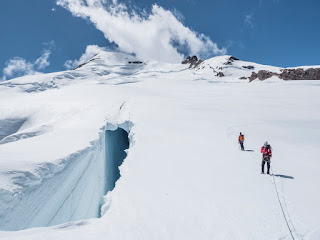It should be noted that once you have a few years of experience, there is some room to re-evaluate some of the rules. However, this should only take place after you have climbed with a lot of different experienced people.
One of the commonly quoted rules for toproped climbing is that one should always use two opposite and opposed lockers at the master point.
The idea is that there is no way that the rope could possibly jump out of two opposite and opposed lockers. And while it may be possible -- however unlikely -- for movement in the system to cause the one of the gates to become unlocked and to open, it would be nearly impossible for the both lockers to become unlocked and to be opened.
In the guiding world, two opposite and opposed lockers are considered to be industry standard. The liklihood of a single locking carabiner becoming unlocked and opening is incredibly low. However, this is one of the rules that you learn when you start to climb and it has become so integral to outdoor groups throughout the world in toproping that it has become the industry standard across the board.
Industry standard is one of those phrases that we should pay attention to in climbing. There are very few things that can be considered industry standard in the climbing world.
That said, it is incredibly unlikely that a single locker in a toprope system will fail. But what if something does go wrong? And what if you were toproping in a way that was outside this standard? Certainly you would feel terrible, and not only that, you would also be hammered by the internet forums, the blogs, and the magazines for doing something considered to be outside the norm. As such, it's probably a good idea to stay within the norm.
Many climbers use two opposite and opposed non-lockers in lieu of two opposite and opposed lockers. Two opposite and opposed non-lockers should be considered the equivalent of one locking carabiner. For non-lockers to have equivalency to two opposite and opposed lockers, there must be three opposite and opposed non-lockers.
Rules in climbing exist to create a wide margin of safety. There's really no reason at all not to have a wide margin of safety in a toproped environment.
--Jason D. Martin
























